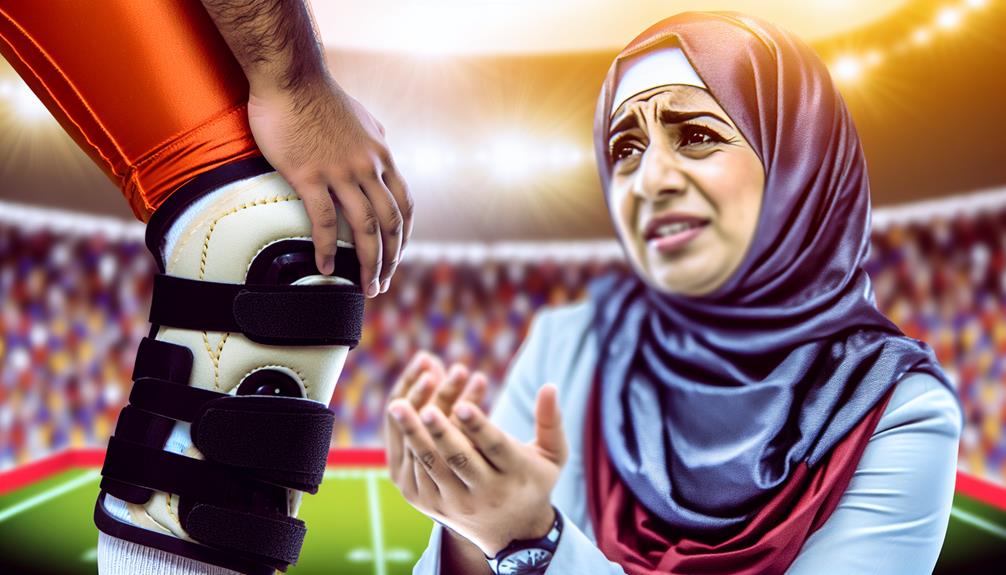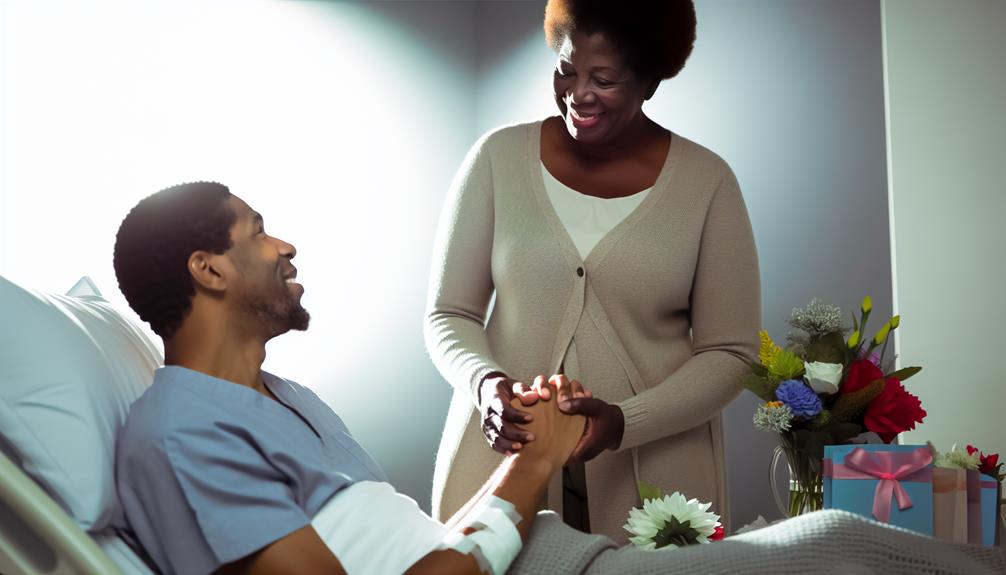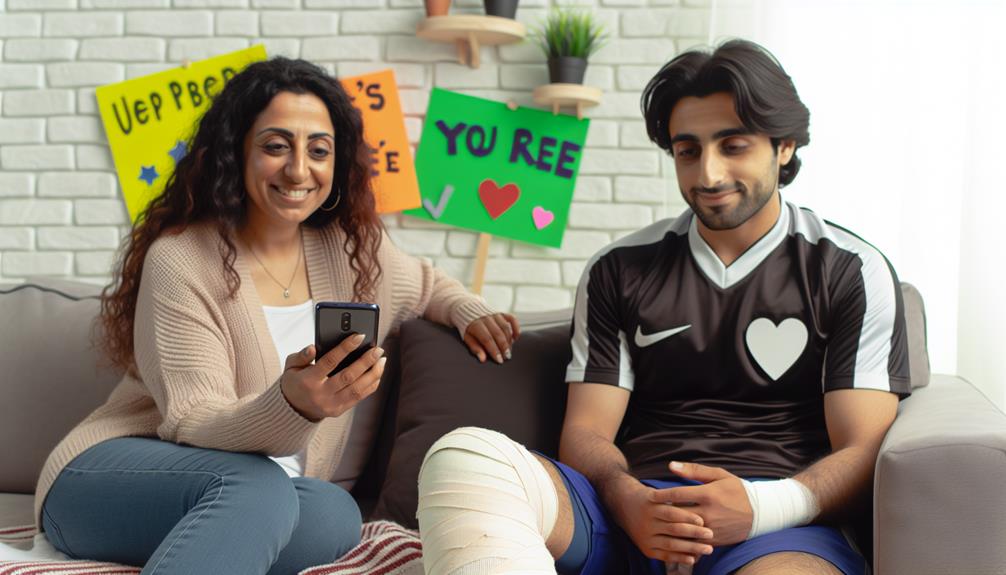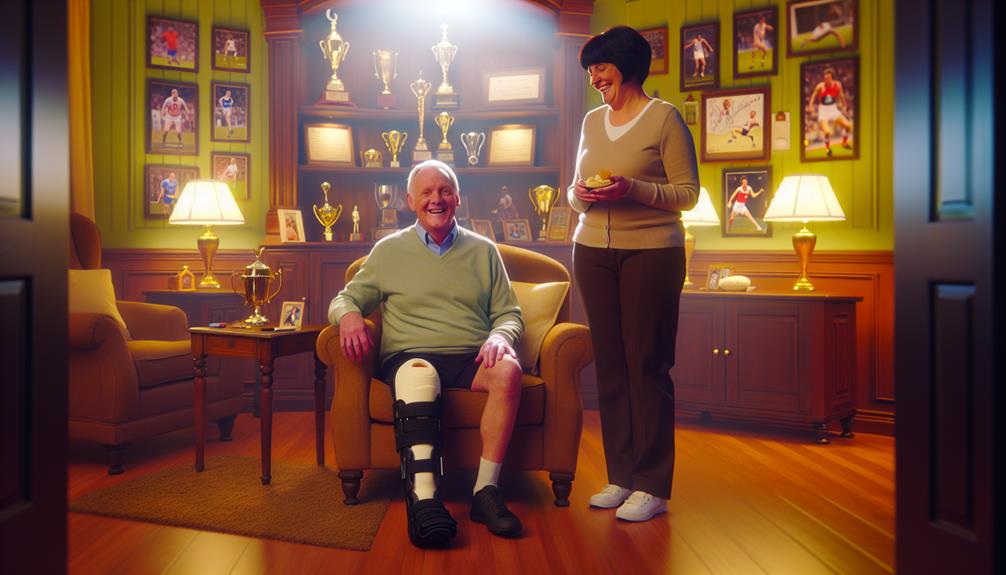Alix Earle's support is vital as Braxton Berrios faces recovery from a significant hamstring injury. Her engagement in his rehabilitation routines not only motivates him but also addresses emotional challenges often faced during healing. Through daily activities, Alix fosters a sense of normalcy and reduces feelings of isolation. The emotional strength derived from strong support systems is important, enhancing resilience and coping mechanisms. Open communication between them further solidifies their bond, allowing fears and frustrations to be shared. This partnership exemplifies the essential role of companionship in recovery, revealing deeper insights into their journey and methods for resilience.
Key Takeaways
- Alix Earle actively engages in Braxton Berrios's rehabilitation routines, boosting his motivation and commitment to recovery.
- She provides crucial emotional support, reducing feelings of isolation and enhancing Braxton's mental well-being during his injury.
- Their open communication strengthens their relationship, allowing for shared experiences and a sense of belonging throughout his recovery journey.
- Alix encourages Braxton to adopt healthier lifestyle choices, reinforcing discipline and focus on both physical and emotional healing.
- Together, they cultivate resilience, navigating the challenges of injury while fostering a supportive and understanding partnership.
Overview of Braxton's Injury

Braxton Berrios, a key player for the Miami Dolphins, recently sustained an injury that has raised concerns about his availability for the remainder of the season. The specifics of the injury suggest a significant setback, with reports indicating that it may involve the hamstring, a crucial muscle for a wide receiver whose performance relies heavily on speed and agility. Such injuries can often lead to lengthy rehabilitation processes, necessitating careful management to prevent further complications. In light of ongoing health challenges faced by other athletes, including recent updates on Bruce Willis's health, it's essential for Berrios to prioritize his recovery.
In the immediate aftermath of the injury, Berrios will undergo a thorough evaluation to ascertain the severity and specific details surrounding the damage. Depending on the diagnosis, the rehabilitation process could range from intensive physical therapy to more invasive treatments, potentially sidelining him for several games.
The Miami Dolphins organization is likely to prioritize Berrios's long-term health over short-term gains, emphasizing the importance of a complete recovery. As fans and teammates rally around him, the collective hope is for a swift and effective rehabilitation process, enabling Berrios to return to the field at full capacity. The team's success hinges not only on individual talent but also on the resilience demonstrated during challenging times.
Alix's Role in Recovery
The support system surrounding injured athletes plays a significant role in their recovery, and Alix Earle has emerged as a prominent figure in Braxton Berrios's rehabilitation journey. Her involvement extends beyond mere companionship; she actively engages in his recovery routines, providing both practical assistance and emotional support. This dual role is essential, as athletes often grapple with physical pain and mental challenges during their rehabilitation.
Alix's commitment not only helps Braxton stay motivated but also fosters a sense of normalcy in his life. By participating in workouts and encouraging healthier lifestyle choices, she reinforces the importance of discipline and resilience. The emotional support she offers mitigates feelings of isolation, allowing Braxton to navigate this challenging period with a sense of belonging.
| Aspect of Support | Alix's Contribution | Impact on Braxton |
|---|---|---|
| Recovery Routines | Participating in workouts | Increased motivation |
| Emotional Support | Providing encouragement | Reduced feelings of isolation |
| Daily Engagement | Sharing daily activities | Enhanced sense of normalcy |
Through these efforts, Alix not only supports Braxton in his physical recovery but also plays a significant role in nurturing his mental well-being.
The Importance of Support

Support plays an essential role in the recovery process, providing emotional strength that can greatly influence outcomes. By fostering resilience together, individuals can navigate challenges more effectively, reinforcing their ability to overcome obstacles. Moreover, the support system can include exploring flexible work opportunities, such as remote customer service jobs, which can alleviate stress during recovery. In addition, open communication is vital, as it guarantees that both parties feel understood and valued, creating a solid foundation for growth and healing.
Emotional Strength During Recovery
Steering the journey of recovery often requires more than just physical healing; it demands considerable emotional strength, which can be bolstered by a strong support system. For individuals like Braxton Berrios, facing injury can trigger a spectrum of emotions that may challenge their mental health. Emotional awareness becomes essential in this scenario, as it allows individuals to recognize and articulate their feelings, fostering a deeper understanding of their emotional landscape.
Support from loved ones, such as Alix Earle, plays a pivotal role in enhancing emotional resilience. This support acts as a buffer against the psychological toll of injury, providing reassurance and companionship during difficult times. Studies show that strong interpersonal relationships can appreciably improve mental health outcomes, facilitating a more positive recovery experience.
Furthermore, the validation of feelings through open communication cultivates a sense of belonging, alleviating feelings of isolation that often accompany physical setbacks. By nurturing emotional strength through connections, individuals are more equipped to navigate the complexities of recovery, ultimately leading to a healthier mind and body. The journey is not just about regaining physical abilities; it is equally about fostering emotional well-being through unwavering support.
Building Resilience Together
Five key elements define the importance of support in building resilience during recovery. First, emotional support fosters an environment where individuals feel valued and understood, enabling them to navigate the emotional turbulence of injury. Second, practical assistance, whether through daily tasks or logistical help, alleviates stress, allowing the individual to focus on recovery. Third, encouragement from loved ones reinforces motivation, essential for maintaining a positive mindset, which is a critical component of effective resilience strategies.
Fourth, shared experiences create a sense of community and belonging, reminding individuals that they are not alone in their struggles. This connection can greatly enhance their coping mechanisms, creating a network of strength. Finally, the establishment of trust within supportive relationships promotes openness, allowing for honest conversations about fears and setbacks, which can ultimately lead to growth.
In the context of Alix Earle and Braxton Berrios, their partnership exemplifies these elements as they navigate the challenges of injury together. By actively building resilience through mutual support, they not only strengthen their bond but also lay the groundwork for a healthier recovery journey.
Importance of Communication
Effective communication serves as a cornerstone in the domain of emotional support, particularly during recovery processes. In the context of Braxton Berrios's injury, Alix Earle's role becomes pivotal, highlighting the importance of fostering an environment where feelings and concerns can be candidly expressed.
Active listening is essential; it requires not only hearing words but also understanding the emotions behind them. This attentive engagement allows individuals to feel validated and understood, which can greatly enhance their emotional resilience. Additionally, establishing an open dialogue creates a safe space for Braxton to articulate his fears and frustrations. This process encourages mutual understanding, reinforcing the bond between partners during challenging times.
Moreover, effective communication can alleviate anxiety and foster a sense of belonging. When both partners openly share their thoughts, it cultivates a partnership built on trust and empathy. This dynamic not only aids in emotional recovery but also strengthens the relationship itself. Ultimately, the importance of communication in support systems cannot be overstated; it is the thread that weaves together emotional healing and relational intimacy, allowing individuals to navigate adversity with shared strength.
Coping Mechanisms for Athletes
Maneuvering the intense pressures of competitive sports requires athletes to employ various coping mechanisms that enhance their mental resilience. One effective strategy is the incorporation of mindfulness techniques, which encourage athletes to focus on the present moment and cultivate a non-judgmental awareness of their thoughts and feelings. This practice can notably reduce anxiety and improve concentration, enabling athletes to better manage the mental strains associated with competition. Additionally, accessing extensive healthcare services can provide essential support for athletes during recovery, ensuring they receive holistic care tailored to their needs comprehensive patient care.
In addition to mindfulness, effective stress management strategies are vital for athletes traversing injuries or performance-related pressures. Techniques such as deep breathing exercises, visualization, and progressive muscle relaxation can help athletes alleviate tension and promote emotional well-being. Engaging in regular physical activity, even during recovery, can also serve as a powerful tool for stress relief, fostering a sense of accomplishment and connection to their sport.
Moreover, fostering a supportive environment—whether through teammates, coaches, or loved ones—can enhance an athlete's ability to cope with challenges. By sharing experiences and emotions, athletes cultivate a sense of belonging, reinforcing their mental fortitude and resilience in the face of adversity. Ultimately, these coping mechanisms are essential for sustaining both performance and overall well-being in the demanding world of competitive sports.
Social Media Influence

In today's digital age, the role of social media in shaping the perceptions and experiences of athletes cannot be overstated. For professional athletes like Braxton Berrios, a well-crafted social media strategy is vital not only for brand building but also for maintaining a connection with fans and supporters during challenging times, such as injury recovery. The strategic use of essential hashtags can notably boost engagement and enhance visibility during these pivotal moments. Alix Earle, as a prominent influencer, exemplifies the considerable impact that social media can have on an athlete's morale and public image.
The influencer impact extends beyond mere visibility; it fosters a sense of community and belonging among followers. Earle's engagement with her audience, coupled with her support for Berrios, highlights how social media can bridge the gap between public personas and personal struggles. This connection humanizes athletes, allowing fans to empathize with their journeys and challenges.
Moreover, the amplification of messages shared through social media can create a supportive environment, which is vital for athletes facing adversity. As Berrios navigates his recovery, the partnership between his public presence and Earle's influence can serve as a powerful reminder of the positive potential of social media in sports culture.
Strengthening Their Relationship
While traversing the complexities of public life, the relationship between Alix Earle and Braxton Berrios exemplifies how mutual support can enhance personal and professional growth within the domain of sports and social media. Their connection showcases intricate relationship dynamics, particularly as they navigate the challenges brought on by Braxton's recent injury. By openly communicating their feelings and needs, they forge a strong emotional bonding that serves as a foundation for their partnership. This commitment mirrors the inspiring transformation seen in individuals who prioritize health and well-being, such as those who initiate journeys to overcome challenges and improve their lives, like Jelly Roll's weight loss journey.
Alix's presence during Braxton's recovery not only highlights her commitment but also reinforces his mental fortitude in overcoming adversity. This unwavering support fosters resilience, an essential quality in both sports and personal relationships. As they share experiences and confront obstacles together, their bond deepens, facilitating a sense of belonging that transcends the pressures of their respective careers.
Moreover, their relationship acts as a powerful reminder of the importance of emotional intelligence in public life. By prioritizing each other's well-being and engaging in positive reinforcement, Alix and Braxton illustrate that nurturing personal connections can lead to enhanced performance and fulfillment, both on and off the field.
Future Outlook for Braxton

Resilience will be a critical factor in Braxton Berrios's future outlook as he navigates the path to recovery following his recent injury. The journey toward rehabilitation necessitates a well-structured approach that not only promotes physical healing but also addresses the mental and emotional aspects of recovery. As he commences on this process, several key rehabilitation strategies will play a significant role:
- Personalized Physical Therapy: Tailored programs that focus on strengthening the injured area will be essential for regaining mobility and function.
- Mental Health Support: Engaging with sports psychologists can help in coping with the emotional challenges that often accompany injuries.
- Nutritional Guidance: A well-rounded diet will support overall health and expedite the healing process.
The career impact of this injury cannot be understated; how Berrios responds will shape his professional trajectory. By embracing resilience and employing effective rehabilitation strategies, he can emerge stronger, potentially leading to a successful return to the field. As he continues to receive support from loved ones like Alix Earle, the foundation for a promising future remains firmly in place.
Lessons From Their Journey
The journey of Braxton Berrios and his support network, including Alix Earle, offers valuable insights into the resilience required during recovery from injury. Their experience highlights the importance of self-care strategies, which are essential not only for physical healing but also for emotional well-being. Berrios's commitment to his rehabilitation underscores the need for athletes to prioritize their health, while Earle's involvement exemplifies how supportive relationships can bolster motivation and encourage perseverance.
Moreover, their relationship dynamics reveal the significance of open communication and mutual support during challenging times. By maneuvering through the complexities of recovery together, they demonstrate that vulnerability can strengthen bonds. This partnership fosters a sense of belonging, reminding us that facing adversity is often easier with someone by our side.
Ultimately, the lessons gleaned from Berrios and Earle's journey extend beyond sports; they resonate with anyone facing personal challenges. By embracing self-care and nurturing supportive relationships, individuals can cultivate resilience and emerge stronger from their trials. Their story serves as a reminder that recovery is not just a solitary endeavor, but a collective journey shaped by love, understanding, and commitment.
Frequently Asked Questions
What Specific Injury Did Braxton Berrios Sustain?
Braxton Berrios recently sustained a significant hamstring injury, which has raised concerns regarding his performance and availability for upcoming games. Recovery strategies for such injuries typically include physical therapy, rest, and targeted rehabilitation exercises designed to restore strength and flexibility. As Berrios navigates this challenging phase, it is essential for him to adhere to a thorough recovery plan to guarantee a successful return to the field, ultimately benefiting both his career and team dynamics.
How Long Is Braxton Expected to Be Sidelined?
The duration of Braxton Berrios's sidelining will largely depend on his rehabilitation timeline and the specific nature of his injury prognosis. Typically, such injuries require a structured recovery plan, which may involve physical therapy and gradual reintegration into training. While precise timelines can vary, monitoring his progress through rehabilitation will provide insights into when he can safely return to competitive play, ensuring both his health and performance are prioritized.
What Are Alix Earle's Personal Insights on Injury Recovery?
Alix's perspective on injury recovery emphasizes the importance of mental fortitude and injury resilience. She believes that maneuvering setbacks requires not only physical rehabilitation but also emotional support and a positive mindset. Alix advocates for fostering a strong support system, highlighting that shared experiences can enhance recovery. By focusing on personal growth during difficult times, individuals can cultivate resilience, ultimately transforming challenges into opportunities for deeper connections and self-discovery within their communities.
How Do Athletes Typically Cope With Mental Health During Injuries?
Athletes often face significant mental health challenges during injuries, necessitating robust coping strategies to maintain mental resilience. Techniques such as mindfulness, visualization, and goal-setting can help mitigate feelings of isolation and frustration. Engaging in open dialogue with coaches and mental health professionals fosters a sense of belonging and support. Additionally, maintaining physical activity within limitations can enhance mood and motivation, ultimately aiding in a more thorough recovery process.
What Role Does Family Play in an Athlete's Recovery Process?
Family plays an important role in an athlete's recovery process, providing essential family support that fosters emotional resilience. The presence of loved ones can alleviate feelings of isolation and anxiety, creating a nurturing environment conducive to healing. Family members often serve as motivators and confidants, helping athletes navigate the psychological challenges of recovery. This strong support network not only enhances emotional well-being but also instills a sense of belonging, which is essential for successful rehabilitation.

